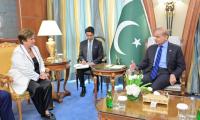LIFTING hundreds of millions of people from poverty to middle class within a generation is a Chinese Miracle of our times.
China was an economic superpower two centuries ago with almost 30 per cent of global GDP and this recent transformation has almost restored her past glory. Several other countries have attempted to copy China’s State Capitalism model to turbocharge their own growth but without comparable success. So, what is China’s secret sauce that may, or may not, be replicated by Pakistan to better serve the needs of its growing population?
For starters, any economic system is directly linked to a nation’s peculiar history, psyche, culture, human development, and politics. Simply put, there is no ‘one size fits all’ formula that works for every discrete ethos, narrative, civilization, and governance structure. The history of the Global South is replete with examples of imported, mostly Western, economic ideologies that ultimately failed the test of ground reality.
Over the course of Pakistan’s 76-year history, we too have experimented with different economic structures including centralized five-year plans, outright nationalization, partial privatization, relatively free enterprise, and some concoction of all. While periodic slowdowns and recessions are commonplace, our rather numerous ‘boom & bust’ cycles stem also from our indecisiveness to stay the course on any one economic model.
Pakistan’s existing governance model has multiple centres of gravity by design. This includes the executive, legislature, bureaucracy, judiciary, and the establishment, in no order of importance but each jealously guarding their turf. Contrary to public expectation and conventional wisdom, the federal government is neither omnipotent nor obligated to do everything under the sun, even when it pretends otherwise. In fact, many of Islamabad’s resources and responsibilities have now been devolved to the provinces (and, at least theoretically, to local governments) under the 18th Constitutional Amendment. The China Model works with a strong central government calling all the shots and holding its subordinates’ feet to the fire on implementation, which is not the case in Pakistan.
Politics plays a big role in any political economy, and here our difference could not be starker with the prevalent one-party system of China. Although that governance setup has served the Chinese people well until now and they will decide what works best for them in the long run, our own history and national temperament does not tolerate one Big Brother for too long. Our diffused and decentralized power structure, with its multiple checks and balances, is an asset if we can strike the right balance. So far in our evolutionary history, it has been a handicap.
Over the past few decades, China became the ‘world’s factory’ not just due to cheap labour but a highly skilled workforce emerging out of their parallel human capital development initiative. Without massively investing in our people’s basic education and vocational training, we will not be able to onshore manufacturing jobs even in those sectors where we might have a few comparative advantages. And, regardless of which economic model we employ, a national emergency on human resource development must be declared to turn our demographic time bomb into a dividend.
As China shifts gears from a predominantly exports-led growth story to domestic consumption, its state-owned enterprises now increasingly work alongside their local private sector counterparts to share the economic pie. Through a mix of state patronage and intervention, this however is a murkier picture of mammoth ‘national champions’ offering great products and services but at the expense of foreign competition. While many countries embrace protectionism and some form of cronyism in their national interest, the sustainability of such market concentration is a double-edged sword that should not be swung blindly by Pakistan.
China’s growth, including its massive infrastructure development, has been fueled by a ton of borrowed money such that its total public and private debt is now almost 250 per cent of GDP, higher than that of the United States. As long as its productive economy keeps growing, that debt burden will be serviceable, but it is also a risky strategy if things go south for any reason. Pakistan’s salvation lies in more equity financing, to the extent we can attract it with sound policies and ease of doing business, and not additional sovereign-guaranteed debt. Although equity is typically more expensive than borrowing, it should be our first port of call going forward.
Pakistan is fortunate to count China as its closest ally that has poured billions into our infrastructure development under the Belt & Road Initiative. We now need to encourage more Chinese companies to set up shop in our special economic zones, give employment opportunities to local youth, and partner with our domestic private sector. This approach should take precedence over future government-to-government transactions. Long derided as a copycat of Western technology, China is now also the world’s most prolific patent filer and can potentially help Pakistan get up the R&D learning curve, including in cleantech.
While we have a lot to learn from the China Model, our own success story would not be defined by a top-down approach but a rules-based system that creates a level playing field for all investors that are able and willing to transact with the Pakistani consumer directly. In an ideal world, the state of Pakistan should restrict its role to providing contractual and property safeguards, policy consistency, safety, and a liberalized marketplace with light-touch regulation. Macroeconomic stability will eventually emerge from this model.
There will always be exceptions and caveats, but our guiding principle should remain the pursuit of individual freedom and economic prosperity in an open and democratic society.
The Senator said the Chief Justice’s statement that he had received no complaint disappointed him
If this trend continues, poor consumers will have to bear an additional burden of at least Rs3.35 per unit, the power...
Maryam Nawaz on Saturday paid a visit to the Samli Syed Muhammad Hussain Government TB Sanatorium Hospital during a...
Abbasi said he had informed the PML-N leadership a year ago that he would not contest the next election from the...
Skipper Babar Azam and Fakhar Zaman stabilized Pakistan innings after early anomaly that the team faced with the...
The training primarily targeted aviation security regulatory officers and inspectors







